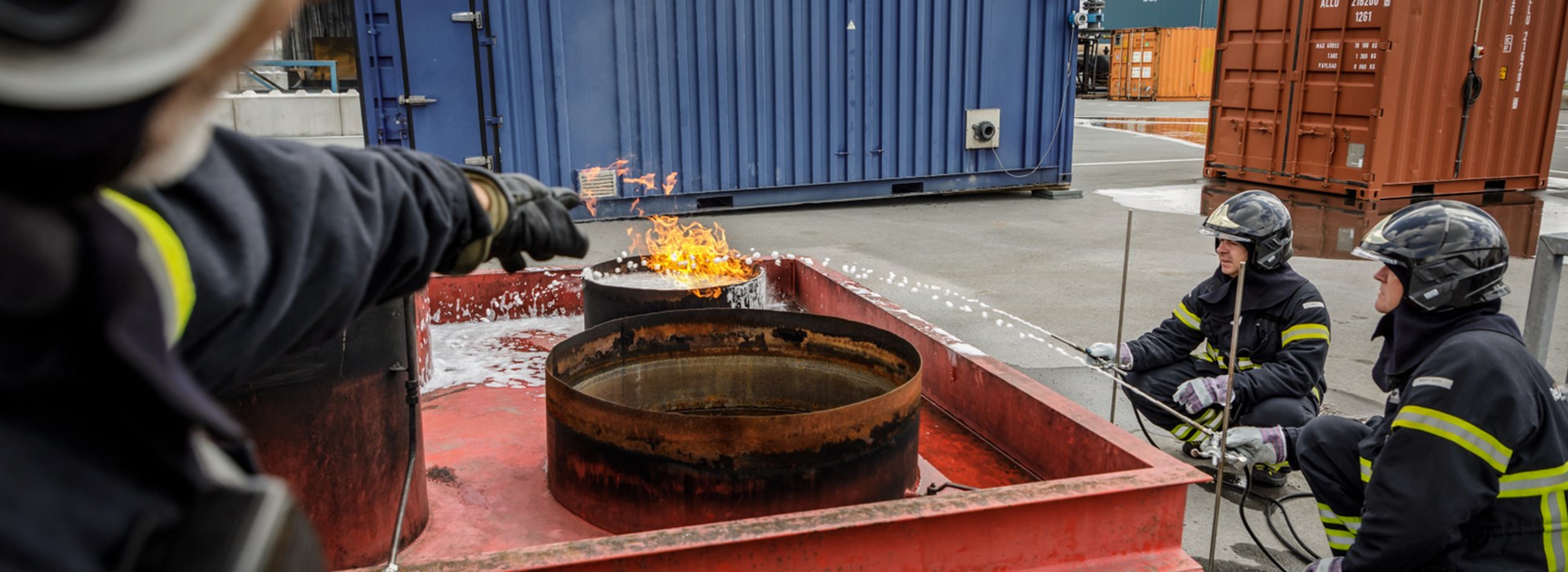Tank table workshop
This training is designed to Increase awareness on the fixed and mobile firefighting systems available in tank and bund firefighting with a tailored theoretical session and demonstrations utilising a scaled Tank Farm Workshop Simulator. There is no theoretical session includes
Aim & objectives
- demonstrate visually the effectiveness of fixed firefighting systems
- demonstrate the tactics and techniques using mobile apparatus on tank fires
Contents
- working effect of fixed foam chambers
- working effect of rim seal pourers
- mobile attack on full surface fires
- sub and semi subsurface systems
- mobile attack on bund fires
- slope froth and boil over characteristics
Prerequisites
None
Duration
1/2 day
The tank table workshop fills the gap between theory and reality
Objectives
The tank and bund firefighting workshops has been designed to give a clearer insight into the tactics and techniques for fighting atmospheric storage tanks and tank bund fires. Using a scaled model of storage tanks and a tank park the participants can visualise how the fixed and mobile firefighting systems works. The practical workshop is a perfect way to bridge the gap between the theoretical studies and the full scale practical exercises. Even the most realistic full-scale tank fire simulators cannot demonstrate all of the aspects of tank incidents without a huge cost to the environment.
Simulations
There are around 17 different demonstrations and interactive exercises possible giving a comprehensive look into tank and bund firefighting techniques, tactics and strategies.
Some of the highlights are as follows:
Fixed firefighting systems
The front line of most tanks fire response, fixed or semi fixed systems are essential lines of defense, but how do they work? How does the foam blanket cover the surface of the burning liquid? What are the weak areas, pitfalls and limitations of these systems?
Fixed roof tank demo
First we look at a fixed roof tank and the most common systems associated with these tanks, namely the foam chamber. With the flow rates matching the recommendations in the National Fire Protection Association guidance, we can see how the foam flows and builds on the surface of the burning liquid. You can also see how the heat attacks the foam layers and under which conditions the system could fail to do its job. The foam performance plays an important role in the efficiency of the system, therefore we conduct the exercises with different types of foam concentrate. The client may wish to bring their own foam concentrate to compare its performance.
Floating roof tank demo
The same demonstrations are performed with a floating roof tank. The roof for these tanks floats on the product and to prevent vapour escaping a seal is fitted to the rim joining the tank shell. A fire within the rim seal area is the most frequent type of incident for this type of tank and if not approached correctly could escalate into a full surface fire. The roof in this model tank actually floats on the stored product and we can see how the foam pourers perform at various roof heights and hence the longer foam travel distances. The demonstration shows how the foam moves down the tank shell and around the rim, illustrating the importance of the foam dam.
Sub surface foam injection demo
These systems are designed to allow foam to travel from the bottom of the tank through the product onto the burning surface. Using glass containers, we can show how the systems performs and the what the effects of inappropriate applications are. We will demonstrate a sub-surface and semi sub surface system, both on hydrocarbon and polar liquids.
Mobile foam attack
Not all tanks have fixed firefighting systems to extinguish a tank fire. According to the NFPA guidance, tanks under 18 meters may be attacked using ground monitors. Similarly, large floating roof tanks may only have provisions to extinguish the rim seal and have no fixed systems for a full surface fire. It is important to understand the strategy, and tactics to extinguish these incidents. The model has two tanks representing 60 and 90 m in diameter. The demonstration shows the need to achieve the correct application rate, where losses are experienced in getting foam to the burning surface. The model can further explore the options how to prevent other tanks nearby becoming involved.
Boil over scenario
Much has been spoken in the past regarding a boil over of crude oil tanks. The heat transcending down from the burning surface eventually reaches the ever-present water in the tanks causing the product to be ejected out of the tank when the water reaches its boiling point. The demonstration using a glass sided tank shows the stratification of the fuel/water layers, the hot and cold zones and the precursors to a boil over.
Bund firefighting strategy
Large bund surrounding tanks, should they fill with product, would give an extremely large surface fi re with numerous complications. The correct capacity equipment is required, however to ensure success the correct strategy needs to be employed. A system of zoning the bund and then progressively attacking one zone at a time will demonstrate an effective and efficient method to extinguish this type of fire quickly without undue risk to the responders.
Courses workshop tank table
1-day training course
Duration
1 day
Number of participants
Min - max persons 8 - 12
Target group
- INDUSTRY: HSE managers, process and safety engineers, safety experts, incident commanders and firefighters working in (petro) chemical and tank storage companies
- PUBLIC SECTOR: Inspection Officers and Fire Officers, Advisors of hazardous Substances
Objectives
After the 1-day tank awareness workshop, participants are familiar with the different types of tank incidents and the operation and limitations of the fixed and mobile extinguishing facilities for tank installations.
Subjects
- tank provisions
- credible scenarios
- foam characteristics and applications rates
- practical demonstration on tank table
4-day training course
Duration
4 days
Number of participants
Min - max Persons 8 - 12
Target group
- INDUSTRY: HSE managers, process and safety engineers, incident commanders, fire officers and team Leaders working in (petro) chemical and tank storage companies
- PUBLIC SECTOR: Inspectors SEVESO regulations, Senior Fire Officers
Objectives
Practical repressive 4-day course in which the participants know the consequences and hazards of a tank incident and can take the most effective measures to combat the tank.
Subjects
- tank construction
- fire detection systems
- fixed firefighting systems
- foam characteristics and applications rates
- credible scenarios
- use of pre-incident plans
- risk assessment for intervention teams
- operational response considerations
- practical demonstration on tank table
- live fire exercises
- virtual reality scenario training
More information and booking
For more information or if you want to book a course, please contact our Business Support on: +31 181 376 666 or fireacademy@nl.relyonnutec.com


